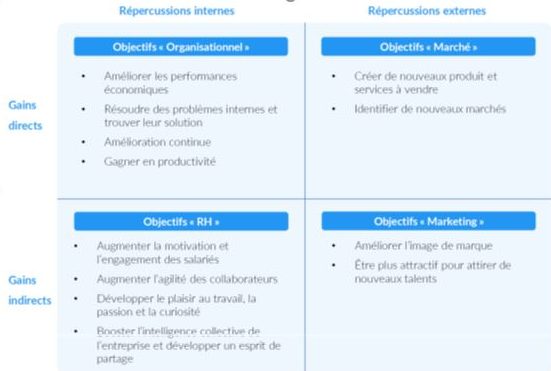The virtues of participation are well known and experienced: at the heart of team management, in the management of projects (strategic, transformation), in the resolution of customer or process problems...
Thus, encouraging a participative innovation approach in the company (via a web platform for example), is in line with the objectives of the company's strategy: innovation (continuous or disruptive improvement), performance, customer loyalty, motivation, gains in internal efficiency, notoriety, well-being at work...
What makes the innovation is the adhesion of the colleagues to the idea, the collective progress, the exploration in team!
Bloom Up Matrix:

What are the key steps?
A quick review of the "Dare to Dare!" approach launched in April 2020 at Ellisphere, co-piloted by the HR Department and the Organization Department.
Dare to Dare" is first and foremost an idea, born out of a managers' seminar, to free up initiative internally, to improve inter-departmental cooperation... beyond the strategic transformation projects carried out in the company over the last few years under the impetus of the CEO. 3 key steps :
- Structuring: defining what, how and when? Based on a benchmark of committed companies and choose a service provider ;
- Prepare the launch: engage in teamwork with ambassadors representing their departments to build the "Dare to Dare" rules of life in conjunction with the Management Committee. In the background, the necessary acculturation to innovation for a large part of the employees, in particular through seminars
- Co-facilitate : moderate with the ambassadors, encourage experimentation in the Lab (feasibility, cost, value) of the most promising ideas, or their implementation in "quick win" mode, encourage openness to tutorials on innovation made available to all.
What can we learn from this?
The strong contribution of the employees (90%) from the launch, will have allowed to bring up many ideas, fed by (generally) informed comments, with the aim :
- Mostly: to improve Ellisphere's service offering, which feeds into the rethinking and improvement of the customer experience, allows us to prioritize product developments in response to customer expectations, and sometimes to innovate in a disruptive way
- For a third party: to improve the fluidity and performance of internal processes, to correct malfunctions (internal continuous improvement)
- For more than a tenth: to contribute to the notoriety of the company (webinars, solidarity...)
- To improve the quality of life at work
In the end, almost a tenth of the ideas were passed on to the Lab or "quick win".
Some key success factors
Some of these are as follows:
- Informal, physical relationships facilitate emulation, commitment, and the self-organization of a Lab team
- Communication and corporate culture are key
- The principles of benevolence and the right to make mistakes as a guideline
- Creating the conditions for continuous innovation by engaging employees, supporting the movement, encouraging exploration... requires time, also in terms of animation (which can be shared with a network of ambassadors) and in terms of duration.


